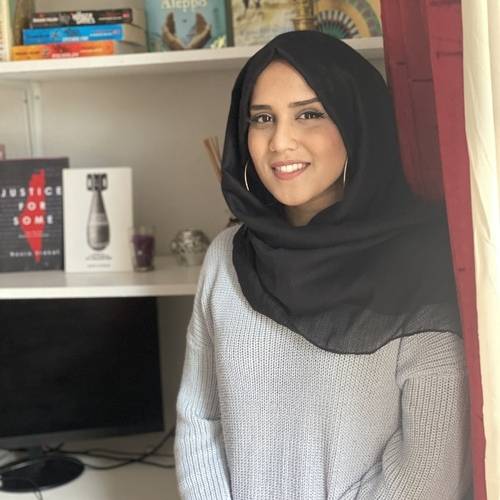Art communicates across every border and culture. Visual art is open and ambiguous, and allows imaginations to wander in time and space. Through London-based artist Alaa Alsaraji, they even wander into people’s homes.
With her family coming from Iraq, she was born in Iran and raised in Austria. Alsaraji has witnessed the rise of Islamophobia, fuelled by hateful media rhetoric, state surveillance and the demonisation and criminalisation of Muslim communities. She notes, however, that despite these internal and external conflicts which have expanded over generations, communities have established and maintained their own safe havens.
Her online exhibition, “Mapping Sanctuaries”, was initially displayed at London’s P21 Gallery. It features a collection of digital illustrations and sound pieces brought by reAct, an innovative programme that promotes dialogue between East and West. Each softly hanging canvas belongs to two authors, the artist and the subject. The illustrator enjoys drawing from life and amplifying the world and people around her, especially the stories of British Muslims.
![London-based artist Alaa Alsaraji in Manchester Art Gallery at the exhibition "Mapping Sanctuaries" [Alaa Alsaraji]](https://i0.wp.com/www.middleeastmonitor.com/wp-content/uploads/2020/11/ee13d68d-626d-4931-aa16-0bf43f703bc7-1.jpg?resize=920%2C1227&ssl=1)
London-based artist Alaa Alsaraji at the exhibition ‘Mapping Sanctuaries’ held in the P21 Gallery [Alaa Alsaraji]
“I illustrated the spaces that we talked about and I used the interviews to edit down a shorter, digestible sound piece that can sit alongside the illustrations to give them more context and understanding as to why a space might hold that kind of weight for someone,” she explains. “Where do you feel safe? Where do you feel free to be yourself without feeling obliged to explain yourself?”
READ: ‘My activism is fueled with love’, says Uyghur campaign searching for her disappeared sister
Othering and marginalisation can occur on a group basis or at the individual level. British Muslims are all likely to have experienced the discomfort of being in a place or with people where they did not feel that they belong, she tells me. “This exhibition revolves around the themes of safety, belonging and familiarity with a space or a place within British Muslim communities. This art is about them.”
Drawing on fieldwork conducted with British Muslims, this small but perfectly focused exhibition challenges the over-simplified hegemonic narratives in the West, and creates a platform for dialogue and expression within their own communities, offering a more nuanced account of their own identities and their space. Each canvas is dyed in one sumptuous colour. This simplicity finds its own intricacies.
Bringing out the textures of the fabric that displays subtle folds of decorative floral patterns, the pieces take on a dynamic life of their own with an almost comic book aesthetic by the use of modern digital techniques. “It really made me understand the ideas around safety and belonging in a much more nuanced and varied way. So there’s also variety in what people said in interviews and what they reflected on and what they feel emotionally connected to. It was beautiful to see that unfold in different directions with each interview.”
A common thread within each interview, she noticed, was the general longing for a space. Some had linked their safe space to the kind of people who would be in it, while others talked more about the smells and objects that they come across which creates a sense of familiarity and safety without having to interact with anyone.
The paintings have been viewed in locations such as Whitechapel, Green Street and alternative community hub Rumi’s Cave in London, and even a bedroom. Viewers may have visited the location before and met Muslims, but the emotional response to Alaa Alsaraji’s work testifies to a shared fund of emotional experience, connection and discovery of local stories. There were gasps and flapping hands pointing and waving towards all corners of the exhibition, followed by a knowing chuckle and nods.
“They all recognise the locations of the spaces and feel that they can resonate with the audio pieces as well. There were also some Muslim women art students who were saying that being artists themselves active in the art scene, which caters more for white middle class people, it’s so rare to walk in and find art that is made for them.”
It is one of the artist’s most uncomfortable truths that, although black and minority artists are enjoying greater representation, it remains a white-dominated field. This is one of the many ways that Muslims in Britain feel “outside” or “othered” because of their identity, explains Alsaraji. “Identity is an omnipresent part of our realities living as minorities and living as Muslims, particularly in the West. It’s just something that you are often made aware of, and reminded of all the time, as if it’s a problem.”
She shares the story of a non-Muslim friend who attended the show and felt some discomfort, but in a positive way, as he was made aware of the realities that he doesn’t have to face every day. “He said that it felt good to sit in that discomfort for a while and be reminded of these things and have a personal, intimate access to people’s experiences in a subtle way.”
After all, could any art exhibition or gallery claim to represent what a certain society or a culture expresses or feels if all of the work showcased was only by white artists?
Alaa Alsaraji’s art collection boils down to the importance of authenticity and providing an honest narrative and viewpoint. She has provided a complete picture showing that British Muslims are integrated and have found places to feel at home in Britain. Put quite simply, she is showing us all that British Muslims are as British as the next person.
READ: Palestine’s Hotdog Van man is successful, despite the pandemic

![London-based artist Alaa Alsaraji at the exhibition 'Mapping Sanctuaries' held in the P21 Gallery [Alaa Alsaraji]](https://i0.wp.com/www.middleeastmonitor.com/wp-content/uploads/2020/11/0f1dd066-acb7-42c6-acd8-2dd4ef232a7e-2-1-e1605628368484.jpg?fit=920%2C613&ssl=1)

![183ec7e5-1ba1-4af2-82fb-aa10ed9c5721 (1) London-based artist Alaa Alsaraji in Manchester Art Gallery at the exhibition "Mapping Sanctuaries" [Alaa Alsaraji]](https://i0.wp.com/www.middleeastmonitor.com/wp-content/uploads/2020/11/183ec7e5-1ba1-4af2-82fb-aa10ed9c5721-1.jpg?w=456&h=342&ssl=1)
![801ad638-5d17-46f5-b041-283015be1564 (1) London-based artist Alaa Alsaraji in Manchester Art Gallery at the exhibition "Mapping Sanctuaries" [Alaa Alsaraji]](https://i0.wp.com/www.middleeastmonitor.com/wp-content/uploads/2020/11/801ad638-5d17-46f5-b041-283015be1564-1.jpg?w=456&h=342&ssl=1)






